Здравствуйте админ, проблема такая, пошёл к приятелю чинить операционную систему, она у него жутко зависала, взял с собой флешку с антивирусной программой, придя, подсоединил «флеху» к USB-порту его ноутбука, но ничего не произошло, накопитель не появился в окне «Компьютер» и в управлении дисками тоже?!
Вытащил флешку и подсоединил к своему ноуту, вышло предупреждение
«Чтобы использовать диск в дисководе F:, сначала отформатируйте его«.
Нажимаю «Форматировать диск«.
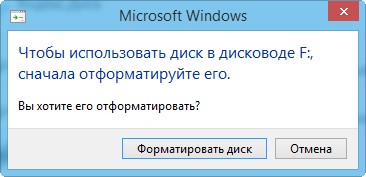
Начать
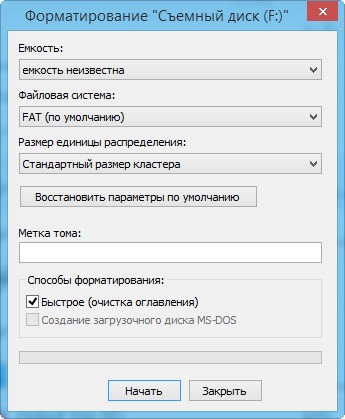
ОК.

Выходит ошибка: «Windows не удаётся завершить форматирование.
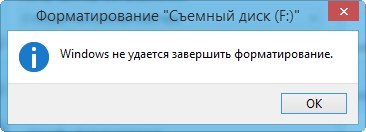
Windows не может отформатировать F. Проверьте правильность подключения дисковода и диска, убедитесь, что диск не только для чтения, а затем повторите попытку».
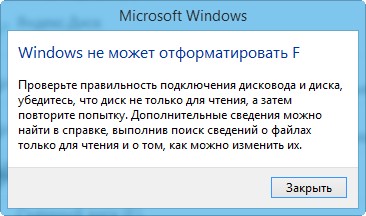
В окне «Компьютер» флешка определяется вот так
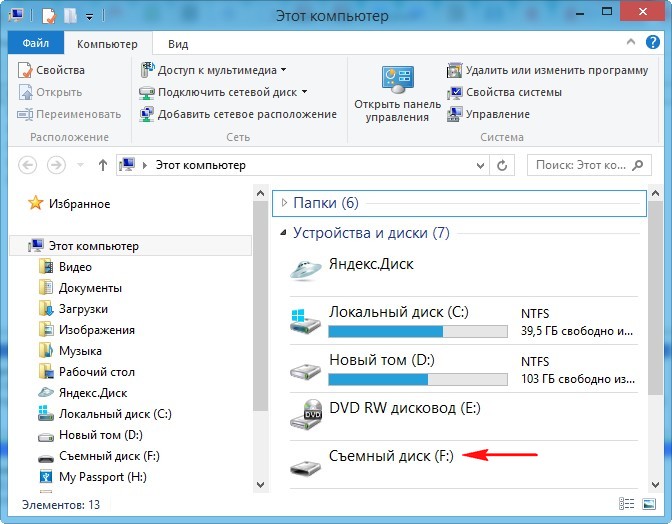
Вот думаю и дела, помочь пришёл человеку, а теперь самому помощь нужна стала!
Худо бедно приятелю вопрос решил, откатил его ноут к заводским настройкам, затем пришёл домой и стал думать, что делать со своей флешкой. Полез в интернеты за советами, а их много, да ни один не помогает.
Один чел посоветовал запустить командную строку от имени администратора и ввести команду
format /FS:NTFS F: /q
Вышло сообщение: Вставьте новый диск в дисковод F: и нажмите клавишу ENTER…
Нажимаю клавишу Enter.
Вышло сообщение: Тип файловой системы: RAW.
Новая файловая система: NTFS.
Быстрое форматирование: 0,0 байт.
Не удаётся определить количество секторов на данном томе.
Сбой форматирования.
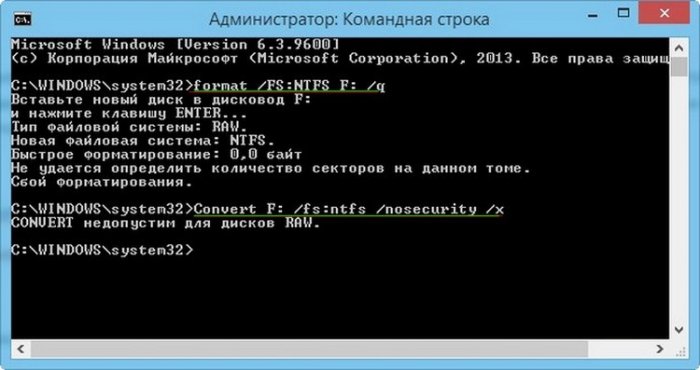
Пробовал команду
Convert F: /fs:ntfs /nosecurity /x
Вышла ошибка: Convert недопустим для дисков RAW.
Короче, хоть бери флешку и выкидывай! Может на вашем сайте подскажут как форматировать флешку в командной строке правильно, чтобы был результат в моём случае?
Как форматировать флешку в командной строке
Привет друзья! Расскажу про все известные мне команды форматирования флешки в командной строке, но сразу оговорюсь, нашему читателю, в его относительно сложном случае, поможет самая последняя команда описанная в этой статье.
Итак, поехали. Запускаем командную строку от имени администратора.
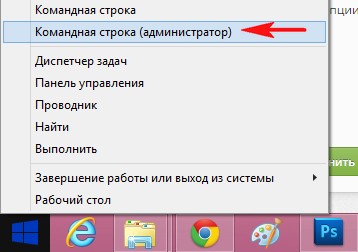
Самая простая команда:
format /fs:NTFS F: /q обозначает, что мы хотим форматировать накопитель имеющий букву (F:) в файловую систему NTFS и метка диска /q нам не нужна (что такое метка, объяснено дальше в статье). Если Вам нужна файловая система FAT32, значит команда будет выглядеть так format /FS:FAT32 F: /q.
Выходит сообщение: «Вставьте новый диск в дисковод F: и нажмите клавишу ENTER…»
Нажимаем ENTER.
Выходит сообщение: «Метка тома (11 символов, ENTER — метка не нужна)»
Нажимаем ENTER.
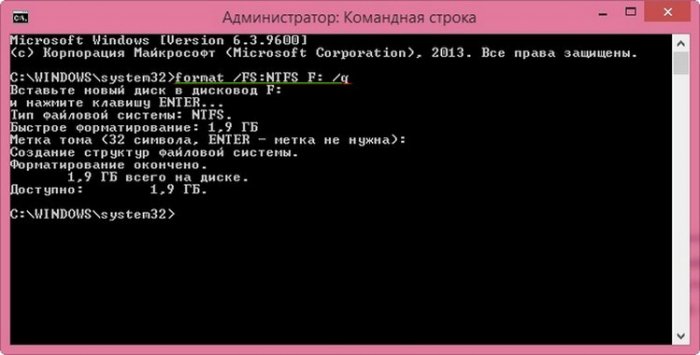
Всё, флешка отформатирована.
Вторая команда:
format F: /fs:NTFS /v:Remontcompa обозначает, что мы хотим форматировать накопитель имеющий букву (F:) в файловую систему NTFS и метка диска будет такая /v:Remontcompa (метку конечно можете выбрать другую). Если Вам нужна файловая система FAT32, значит команда будет выглядеть так format F: /fs:FAT32 /v:Remontcompa.
Выходит сообщение: «Вставьте новый диск в дисковод F: и нажмите клавишу ENTER…»
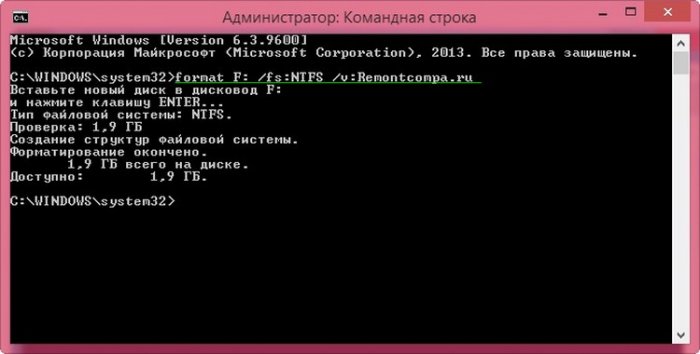
Флешка отформатирована.
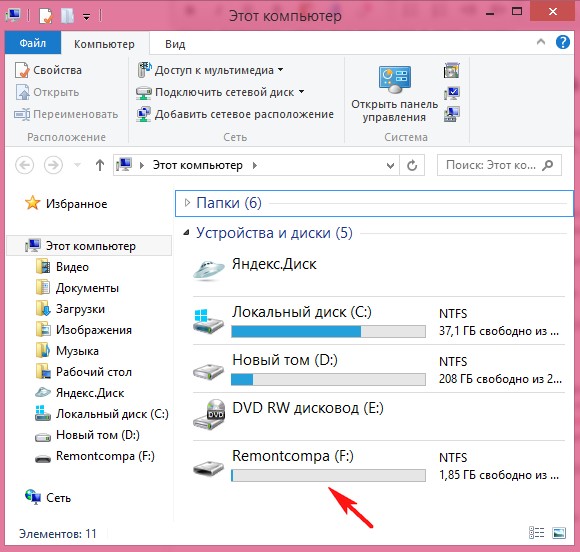
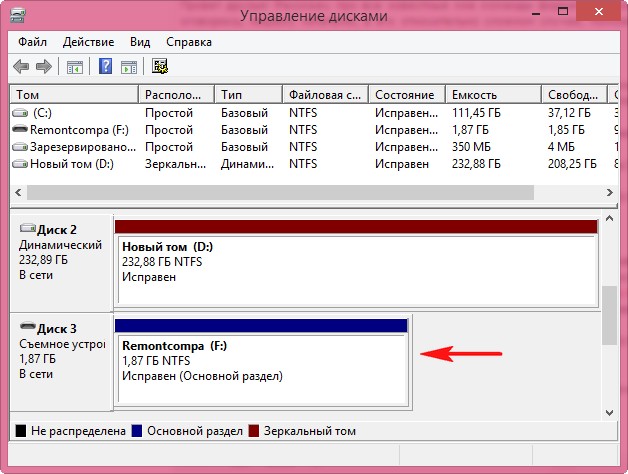
И наконец, третья команда отформатирует вашу флешку при любых ошибках (конечно, если флешка исправна).
Набираем в командной строке:
diskpart — утилита управления дискового пространства
list disk — отображается весь список дисков, наша флешка под номером три (определяйтесь по объёму).
select disk 3 (3 — это число, соответствующее нашей флешке)
attributes disk clear readonly — очистка атрибутов.
clean — очистка флешки.
create partition primary — создание первичного раздела.
format fs=ntfs (или format fs=fat32, если нужна файловая система fat32. Также можете применить быстрое форматирование командой format fs=NTFS QUICK)
exit
Не могу удалить данные с карты Micro-SD.
Проверь механический ограничитель на карте или картридере,
Это тупо, но я один раз попался. Такой бегунок
Попробуй пересоздать раздел на ней.
А зайти в свойства карты на вкладку безопасность и тупо выдать себе разрешения не догадался?
Проблемма была таже . Нашел выход из ситуации. У меня не форматировались файлы и сама карта микросд.
Но карта открывалась. И файлы переносились на комп. Но, карта не форматировалась писала что нет доступа итд….
Выход:
1)Для начало нужно открыть карту на win 7
2) выбрать 1 файл ( файлы мои были прописаны китайскими иероглифами) -св-во
3) войти во вкладку подробно
4) в самом низу есть надпись (ссылка) «Удаление свойств и личной информации»
5) заходим туда
6) ставим курсор на » Удалить следущие свойства для этого файла»
7) ставимво всех пунктах галочки и ОК
тупо удаляеем файл который нам требуеться, или все файлы чтобы форматнуть micro sd
Схожая проблема..
Картa SanDisk Ultra64Gb — Возможная причина: использование карты не по назначению — постоянно перезаписывал файлы..
До сих пор не удалось форматнуть.. Сколько не старался)
Кто смог — будьте добры скажите как — буду БлагоДарен:)
Купи другой адаптер, или если у тебя есть другой, то вставь MicroSD туда и всё будет удаляться
Войдите, чтобы написать ответ
I’ve been trying to write an .img file tonight with no success, and it’s only gotten worse. I pulled up rufus, selected my image, and told it to write. I get a general fail message. The log file gives an error 5, access denied. My account is an administrator, but I forced rufus to run as Administrator. Still no luck. I then used Win32DiskImager, and got the same problem. I’ve tried a handful of different branded flash drives, on different USB ports (both 2.0 and 3.0). I can use Windows Explorer and Computer Management to format just fine, and tested it does have read/write (e.g. I saved a text file to the flash drive). Then I tried DiskPart, and when I ran the clean command, I got that same error 5. Event viewer gives me «Cannot zero sectors on disk ?PhysicalDrive1. Error code: ?PhysicalDrive1». The source is «VDS Basic Provider», and the error code (from Details tab) is
«5@0101000F».
I’m assuming both Rufus and Win32DiskImager both use the same method to wipe and reformat the disk (some Windows storage API), which is why they both fail. What doesn’t make sense is how Computer Management and Windows Explorer are allowed to do it. I’ve even used Process Explorer to verify no other service is locking the drive. The only program is Windows Explorer, but that’s normal. Even when it’s ended (and no other programs are interacting with the drive), I still can’t clean the drive.
I’m running Windows 7 Home Premium SP1 x64.
Edit: I tried another flash drive (one I hadn’t used in a while). It seems running clean on that makes the drive disappear from Computer Management. Requires a few rescans, and initialization and then I can use it again.
Незадолго до этого я запустил dd на USB-накопителе, но позже, когда мне это было нужно. Я обнаружил, что он не может быть отформатирован в Windows Disk Management, который говорит: «Система не может найти указанный файл». Итак, мой USB-накопитель отформатирован в Linux.
Теперь проблема возникает. Windows 8.1 не назначает букву диска, что делает невозможным доступ к ней в проводнике Windows, и хотя она отображается в WDM, любая операция возвращала сообщение, упомянутое выше. Но нет проблем, когда в Linux на моей машине и в Windows на другой машине.
Как мы выяснили из комментариев, проблема может быть решена с помощью дисковой части Windows. Очевидно, что инструменты Linux каким-то образом создали MBR и / или таблицу разделов, которые Windows не могла правильно прочитать (или имела какую-то другую проблему).
Если вы используете эти инструкции, делайте это с осторожностью! Ошибки могут означать, что вы теряете все данные еще на одном диске. Если вы не уверены, пусть это сделает кто-то более опытный!
-
Откройте меню «Пуск» и введите diskpart. Вы должны получить один удар, запустить его и подтвердить запрос UAC, если вас спросят.
-
Подождите, пока в окне консоли не появится курсор ввода (мигающая горизонтальная линия за
DISKPART>). -
Наберите
list diskи подтвердите нажатием Return. -
Найдите диск, который вы хотите отформатировать / сбросить. Дважды проверьте, правильно ли вы выбрали. Запомните его номер (указан под
###) для следующего шага. -
Теперь введите
select disk #где#заменяется номером с последнего шага. -
Еще раз введите
list diskи правильный диск должен быть помечен*перед ним. -
Введите
clean, подтвердите запрос и дождитесь окончания операции. -
Оставьте diskpart, используя
exit. -
Теперь проводник Windows должен спросить вас, что делать с неинициализированным / пустым диском. Если это не так, взгляните на управление дисками (откройте меню «Пуск» и запустите
diskmgmt.msc). Вы должны найти неинициализированный диск и иметь возможность создавать новые разделы и форматировать их.
У меня была точно такая же проблема, и решение Марио не решило мою проблему.
В дополнение к решению Марио сделайте следующее:
- после ‘
clean‘ не оставляйте diskpart, используя ‘exit‘ - введите «
create partition primary»
Это создаст основной раздел FAT32 (что было невозможно из диспетчера дисков, как описано в комментарии к решению «Станислав Мамонтов» для Mario). Этот раздел будет распознан, непосредственно смонтирован и доступен. Теперь вы можете переформатировать, например, NTFS, если это необходимо.
изменён Steven M. Vascellaro5k
ответ дан Vladislav Kuzmin71
В моем случае команда create primary partition не помогла. Управление дисками по-прежнему не удалось с « Система не может найти указанный файл ».
В конечном итоге проблема была решена следующим образом: вместо использования команды clean в утилите DISKPART я использовал clean all . Эта команда записывает нули в каждый сектор диска, эффективно создавая истинное неразделенное пространство. Это займет некоторое время, но это работает.
После этого вы можете создать новый раздел, отформатировать и выделить букву в разделе «Управление дисками».
Решение эквивалентно использованию менеджера разделов Easeus, упомянутого выше, но вы можете сделать это без установки какого-либо стороннего инструмента. Таким образом, ключ в том, чтобы действительно очистить флешку перед созданием нового раздела.
ответ дан Bogdan Vosnjak11
Подобная проблема, Verbatim Store ‘n Go, не могла ничего с этим поделать в Windows 10. Windows 7 была в состоянии получить к нему доступ нормально. Форматирование на машине с Windows 7 не помогло. Средство «Управление дисками» в приложении «Управление компьютером» продолжало выдавать ошибки (при попытке назначить букву диска оно выдавало ошибку «Не удается найти указанный файл»). Удаление разделов и воссоздание не помогли.
Для меня Марио в Diskpart Solution продолжал выдавать ошибку «Доступ запрещен», в журнале событий было указано следующее: 5 @ 0101000F — Не удается обнулить секторы на диске ?PhysicalDrive1. Код ошибки: ?PhysicalDrive1
Попытка «создать основной раздел» после «очистки» также не сработала.
Попытка Paragon стереть диск и воссоздать раздел, это «удалось», но первоначальная проблема осталась.
Что сработало, так это SD Memory Card Formatter
Возможно, некоторые из этих новых USB-накопителей — это просто SD-карты с адаптером? В любом случае стоит попробовать SD Memory Card Formatter.
Вот решение, которое я нашел после того, как попробовал так много решений из Интернета ….. сначала скачайте менеджер разделов easeus и удалите ваш флеш-накопитель, чтобы он был преобразован в нераспределенное пространство, теперь откройте управление дисками, нажав на кнопку записи на моем компьютере, а затем выбрав «Управление», а затем «Управление дисками», теперь вы увидите незанятое пространство вашего флешки в управлении дисками. Теперь напишите, нажмите на него и выберите новый простой том, затем введите имя диска и выберите тип формата ntfs/fat32, затем вуаля, он будет исправлен без любая стычка …. работала на меня после всего, что я пробовал из интернета ….. конечно, это будет работать для вас, ребята
ответ дан Lalit Singh Fauzdar101
Всё ещё ищете ответ? Посмотрите другие вопросы с метками windows-8.1 usb-flash-drive.
Not long before, I executed dd on my USB drive, but later when I needed it. I found it could not be formatted in Windows Disk Management, which said «The system cannot find the file specified.» So I had my USB drive formatted on Linux.
now issue occur. Windows 8.1 does not assign a drive letter, making it unable to be accessed in Windows Explorer, and though it is shown in WDM, any operation returned message mentioned above. But there is no problem when on Linux on my machine and on Windows on another machine.
asked May 17, 2014 at 7:31
NoverullNoverull
6732 gold badges8 silver badges16 bronze badges
12
As we found out through the comments the problem may be solved using Windows’ diskpart. Obviously the Linux tools somehow created a MBR and/or partition table Windows couldn’t read properly (or had some other issue with).
If you’re using these instructions, do so with care! Making mistakes might mean you’re losing all data on one more more disks. If you’re unsure, let someone else who’s more experienced do this!
-
Open the start menu and type diskpart. You should get one hit, launch it and confirm the UAC prompt in case you’re asked.
-
Wait for the console window to show an input cursor (flashing horizontal line behind
DISKPART>). -
Type
list diskand confirm with Return. -
Locate the disk you’d like to format/reset. Double check you pick the right one. Remember its number (listed under
###) for the next step. -
Now type
select disk #where#is replaced with the number from the last step. -
Once again type
list diskand the correct disk should be marked with a*in front of it. -
Type
clean, confirm if asked and wait for the operation to finish. -
Leave diskpart using
exit. -
Windows Explorer should now ask you what to do with the uninitialized/empty disk. If it doesn’t, have a look at disk management (open the start menu and run
diskmgmt.msc). You should find the uninitialized drive and be able to create new partitions and format them.
answered May 20, 2014 at 16:50
MarioMario
4,2562 gold badges20 silver badges22 bronze badges
2
I had exactly the same issue and the Mario’s solution did not fix my problem.
Additionally to Mario’s solution do the following:
- after ‘
clean‘ do not leave diskpart using ‘exit‘ - type ‘
create partition primary‘
This will create primary FAT32 partition (which was not possible from the Disk Manager as described in comment of ‘Stanislav Mamontov’ to Mario solution). This partition will be recognized, directly mounted and available. Now you can reformat to e.g NTFS if needed.
![]()
Stevoisiak
13k36 gold badges96 silver badges150 bronze badges
answered Feb 3, 2015 at 8:31
1
Similar issue, Verbatim Store ‘n Go, couldn’t do anything with it on Windows 10. Windows 7 was able to access it fine. Formatting on the Windows 7 machine did not help. The Disk Management tool in the Computer Management app kept throwing errors (when trying to assign a drive letter it kept throwing a «Cannot find file specified» error). Deleting partitions there and recreating didn’t help.
For me Mario’s Diskpart Solution kept throwing an error «Access is Denied», with the following in event log: 5@0101000F — Cannot zero sectors on disk ?PhysicalDrive1. Error code: ?PhysicalDrive1
Trying a «create primary partition» after «clean» did not work either.
Tried Paragon to wipe the disk and recreate the partition, this «succeeded» but the original problem persisted.
What did work was SD Memory Card Formatter
Perhaps some of these newer USB drives are just SD cards with an adapter? In any case, it’s worth it to try SD Memory Card Formatter.
answered Jun 29, 2018 at 10:26
![]()
In my case, the create primary partition command did not help. Disk Management still failed with «The system cannot find the file specified«.
What ultimately solved the problem was this: instead of using the clean command in DISKPART utility, I used clean all. This command writes zeroes in every sector of the disk, effectively creating a true unpartitioned space. It takes some time, but it works.
Afterwards you can create a new partition, format and allocate the letter in Disk Management.
The solution is equivalent to using Easeus partition manager mentioned above, but you can do it without installing any 3rd-party tool. So the key is really to wipe the USB stick clean before creating a new partition.
answered Oct 11, 2016 at 16:03
If using DISKPART to clean the disk and remake the partition doesn’t work, look at some of the answers on Recovering a Partially Formatted USB Thumb Drive. I found that after doing all of Mark Tomlin’s answer, I had to repeat it but converting to GPT instead of MBR. That worked. I then converted back to MBR (which had a few problems that I solved as explained on the other post).
answered Jun 18, 2021 at 18:19
Alasdair KAlasdair K
1941 silver badge4 bronze badges
Not long before, I executed dd on my USB drive, but later when I needed it. I found it could not be formatted in Windows Disk Management, which said «The system cannot find the file specified.» So I had my USB drive formatted on Linux.
now issue occur. Windows 8.1 does not assign a drive letter, making it unable to be accessed in Windows Explorer, and though it is shown in WDM, any operation returned message mentioned above. But there is no problem when on Linux on my machine and on Windows on another machine.
asked May 17, 2014 at 7:31
NoverullNoverull
6732 gold badges8 silver badges16 bronze badges
12
As we found out through the comments the problem may be solved using Windows’ diskpart. Obviously the Linux tools somehow created a MBR and/or partition table Windows couldn’t read properly (or had some other issue with).
If you’re using these instructions, do so with care! Making mistakes might mean you’re losing all data on one more more disks. If you’re unsure, let someone else who’s more experienced do this!
-
Open the start menu and type diskpart. You should get one hit, launch it and confirm the UAC prompt in case you’re asked.
-
Wait for the console window to show an input cursor (flashing horizontal line behind
DISKPART>). -
Type
list diskand confirm with Return. -
Locate the disk you’d like to format/reset. Double check you pick the right one. Remember its number (listed under
###) for the next step. -
Now type
select disk #where#is replaced with the number from the last step. -
Once again type
list diskand the correct disk should be marked with a*in front of it. -
Type
clean, confirm if asked and wait for the operation to finish. -
Leave diskpart using
exit. -
Windows Explorer should now ask you what to do with the uninitialized/empty disk. If it doesn’t, have a look at disk management (open the start menu and run
diskmgmt.msc). You should find the uninitialized drive and be able to create new partitions and format them.
answered May 20, 2014 at 16:50
MarioMario
4,2562 gold badges20 silver badges22 bronze badges
2
I had exactly the same issue and the Mario’s solution did not fix my problem.
Additionally to Mario’s solution do the following:
- after ‘
clean‘ do not leave diskpart using ‘exit‘ - type ‘
create partition primary‘
This will create primary FAT32 partition (which was not possible from the Disk Manager as described in comment of ‘Stanislav Mamontov’ to Mario solution). This partition will be recognized, directly mounted and available. Now you can reformat to e.g NTFS if needed.
![]()
Stevoisiak
13k36 gold badges96 silver badges150 bronze badges
answered Feb 3, 2015 at 8:31
1
Similar issue, Verbatim Store ‘n Go, couldn’t do anything with it on Windows 10. Windows 7 was able to access it fine. Formatting on the Windows 7 machine did not help. The Disk Management tool in the Computer Management app kept throwing errors (when trying to assign a drive letter it kept throwing a «Cannot find file specified» error). Deleting partitions there and recreating didn’t help.
For me Mario’s Diskpart Solution kept throwing an error «Access is Denied», with the following in event log: 5@0101000F — Cannot zero sectors on disk ?PhysicalDrive1. Error code: ?PhysicalDrive1
Trying a «create primary partition» after «clean» did not work either.
Tried Paragon to wipe the disk and recreate the partition, this «succeeded» but the original problem persisted.
What did work was SD Memory Card Formatter
Perhaps some of these newer USB drives are just SD cards with an adapter? In any case, it’s worth it to try SD Memory Card Formatter.
answered Jun 29, 2018 at 10:26
![]()
In my case, the create primary partition command did not help. Disk Management still failed with «The system cannot find the file specified«.
What ultimately solved the problem was this: instead of using the clean command in DISKPART utility, I used clean all. This command writes zeroes in every sector of the disk, effectively creating a true unpartitioned space. It takes some time, but it works.
Afterwards you can create a new partition, format and allocate the letter in Disk Management.
The solution is equivalent to using Easeus partition manager mentioned above, but you can do it without installing any 3rd-party tool. So the key is really to wipe the USB stick clean before creating a new partition.
answered Oct 11, 2016 at 16:03
If using DISKPART to clean the disk and remake the partition doesn’t work, look at some of the answers on Recovering a Partially Formatted USB Thumb Drive. I found that after doing all of Mark Tomlin’s answer, I had to repeat it but converting to GPT instead of MBR. That worked. I then converted back to MBR (which had a few problems that I solved as explained on the other post).
answered Jun 18, 2021 at 18:19
Alasdair KAlasdair K
1941 silver badge4 bronze badges
I’ve been trying to write an .img file tonight with no success, and it’s only gotten worse. I pulled up rufus, selected my image, and told it to write. I get a general fail message. The log file gives an error 5, access denied. My account is an administrator, but I forced rufus to run as Administrator. Still no luck. I then used Win32DiskImager, and got the same problem. I’ve tried a handful of different branded flash drives, on different USB ports (both 2.0 and 3.0). I can use Windows Explorer and Computer Management to format just fine, and tested it does have read/write (e.g. I saved a text file to the flash drive). Then I tried DiskPart, and when I ran the clean command, I got that same error 5. Event viewer gives me «Cannot zero sectors on disk \?PhysicalDrive1. Error code: \?PhysicalDrive1». The source is «VDS Basic Provider», and the error code (from Details tab) is
«5@0101000F».
I’m assuming both Rufus and Win32DiskImager both use the same method to wipe and reformat the disk (some Windows storage API), which is why they both fail. What doesn’t make sense is how Computer Management and Windows Explorer are allowed to do it. I’ve even used Process Explorer to verify no other service is locking the drive. The only program is Windows Explorer, but that’s normal. Even when it’s ended (and no other programs are interacting with the drive), I still can’t clean the drive.
I’m running Windows 7 Home Premium SP1 x64.
Edit: I tried another flash drive (one I hadn’t used in a while). It seems running clean on that makes the drive disappear from Computer Management. Requires a few rescans, and initialization and then I can use it again.
Здравствуйте админ, проблема такая, пошёл к приятелю чинить операционную систему, она у него жутко зависала, взял с собой флешку с антивирусной программой, придя, подсоединил «флеху» к USB-порту его ноутбука, но ничего не произошло, накопитель не появился в окне «Компьютер» и в управлении дисками тоже?!
Вытащил флешку и подсоединил к своему ноуту, вышло предупреждение
«Чтобы использовать диск в дисководе F:, сначала отформатируйте его«.
Нажимаю «Форматировать диск«.

Начать

ОК.

Выходит ошибка: «Windows не удаётся завершить форматирование.

Windows не может отформатировать F. Проверьте правильность подключения дисковода и диска, убедитесь, что диск не только для чтения, а затем повторите попытку».

В окне «Компьютер» флешка определяется вот так

Вот думаю и дела, помочь пришёл человеку, а теперь самому помощь нужна стала!
Худо бедно приятелю вопрос решил, откатил его ноут к заводским настройкам, затем пришёл домой и стал думать, что делать со своей флешкой. Полез в интернеты за советами, а их много, да ни один не помогает.
Один чел посоветовал запустить командную строку от имени администратора и ввести команду
format /FS:NTFS F: /q
Вышло сообщение: Вставьте новый диск в дисковод F: и нажмите клавишу ENTER…
Нажимаю клавишу Enter.
Вышло сообщение: Тип файловой системы: RAW.
Новая файловая система: NTFS.
Быстрое форматирование: 0,0 байт.
Не удаётся определить количество секторов на данном томе.
Сбой форматирования.

Пробовал команду
Convert F: /fs:ntfs /nosecurity /x
Вышла ошибка: Convert недопустим для дисков RAW.
Короче, хоть бери флешку и выкидывай! Может на вашем сайте подскажут как форматировать флешку в командной строке правильно, чтобы был результат в моём случае?
Как форматировать флешку в командной строке
Привет друзья! Расскажу про все известные мне команды форматирования флешки в командной строке, но сразу оговорюсь, нашему читателю, в его относительно сложном случае, поможет самая последняя команда описанная в этой статье.
Итак, поехали. Запускаем командную строку от имени администратора.

Самая простая команда:
format /fs:NTFS F: /q обозначает, что мы хотим форматировать накопитель имеющий букву (F:) в файловую систему NTFS и метка диска /q нам не нужна (что такое метка, объяснено дальше в статье). Если Вам нужна файловая система FAT32, значит команда будет выглядеть так format /FS:FAT32 F: /q.
Выходит сообщение: «Вставьте новый диск в дисковод F: и нажмите клавишу ENTER…»
Нажимаем ENTER.
Выходит сообщение: «Метка тома (11 символов, ENTER — метка не нужна)»
Нажимаем ENTER.

Всё, флешка отформатирована.
Вторая команда:
format F: /fs:NTFS /v:Remontcompa обозначает, что мы хотим форматировать накопитель имеющий букву (F:) в файловую систему NTFS и метка диска будет такая /v:Remontcompa (метку конечно можете выбрать другую). Если Вам нужна файловая система FAT32, значит команда будет выглядеть так format F: /fs:FAT32 /v:Remontcompa.
Выходит сообщение: «Вставьте новый диск в дисковод F: и нажмите клавишу ENTER…»

Флешка отформатирована.


И наконец, третья команда отформатирует вашу флешку при любых ошибках (конечно, если флешка исправна).
Набираем в командной строке:
diskpart — утилита управления дискового пространства
list disk — отображается весь список дисков, наша флешка под номером три (определяйтесь по объёму).
select disk 3 (3 — это число, соответствующее нашей флешке)
attributes disk clear readonly — очистка атрибутов.
clean — очистка флешки.
create partition primary — создание первичного раздела.
format fs=ntfs (или format fs=fat32, если нужна файловая система fat32. Также можете применить быстрое форматирование командой format fs=NTFS QUICK)
exit
Not long before, I executed dd on my USB drive, but later when I needed it. I found it could not be formatted in Windows Disk Management, which said «The system cannot find the file specified.» So I had my USB drive formatted on Linux.
now issue occur. Windows 8.1 does not assign a drive letter, making it unable to be accessed in Windows Explorer, and though it is shown in WDM, any operation returned message mentioned above. But there is no problem when on Linux on my machine and on Windows on another machine.
asked May 17, 2014 at 7:31
NoverullNoverull
6732 gold badges8 silver badges16 bronze badges
12
As we found out through the comments the problem may be solved using Windows’ diskpart. Obviously the Linux tools somehow created a MBR and/or partition table Windows couldn’t read properly (or had some other issue with).
If you’re using these instructions, do so with care! Making mistakes might mean you’re losing all data on one more more disks. If you’re unsure, let someone else who’s more experienced do this!
-
Open the start menu and type diskpart. You should get one hit, launch it and confirm the UAC prompt in case you’re asked.
-
Wait for the console window to show an input cursor (flashing horizontal line behind
DISKPART>). -
Type
list diskand confirm with Return. -
Locate the disk you’d like to format/reset. Double check you pick the right one. Remember its number (listed under
###) for the next step. -
Now type
select disk #where#is replaced with the number from the last step. -
Once again type
list diskand the correct disk should be marked with a*in front of it. -
Type
clean, confirm if asked and wait for the operation to finish. -
Leave diskpart using
exit. -
Windows Explorer should now ask you what to do with the uninitialized/empty disk. If it doesn’t, have a look at disk management (open the start menu and run
diskmgmt.msc). You should find the uninitialized drive and be able to create new partitions and format them.
answered May 20, 2014 at 16:50
MarioMario
4,2662 gold badges21 silver badges22 bronze badges
2
I had exactly the same issue and the Mario’s solution did not fix my problem.
Additionally to Mario’s solution do the following:
- after ‘
clean‘ do not leave diskpart using ‘exit‘ - type ‘
create partition primary‘
This will create primary FAT32 partition (which was not possible from the Disk Manager as described in comment of ‘Stanislav Mamontov’ to Mario solution). This partition will be recognized, directly mounted and available. Now you can reformat to e.g NTFS if needed.
![]()
Stevoisiak
13.4k37 gold badges100 silver badges152 bronze badges
answered Feb 3, 2015 at 8:31
1
Similar issue, Verbatim Store ‘n Go, couldn’t do anything with it on Windows 10. Windows 7 was able to access it fine. Formatting on the Windows 7 machine did not help. The Disk Management tool in the Computer Management app kept throwing errors (when trying to assign a drive letter it kept throwing a «Cannot find file specified» error). Deleting partitions there and recreating didn’t help.
For me Mario’s Diskpart Solution kept throwing an error «Access is Denied», with the following in event log: 5@0101000F — Cannot zero sectors on disk ?PhysicalDrive1. Error code: ?PhysicalDrive1
Trying a «create primary partition» after «clean» did not work either.
Tried Paragon to wipe the disk and recreate the partition, this «succeeded» but the original problem persisted.
What did work was SD Memory Card Formatter
Perhaps some of these newer USB drives are just SD cards with an adapter? In any case, it’s worth it to try SD Memory Card Formatter.
answered Jun 29, 2018 at 10:26
![]()
In my case, the create primary partition command did not help. Disk Management still failed with «The system cannot find the file specified«.
What ultimately solved the problem was this: instead of using the clean command in DISKPART utility, I used clean all. This command writes zeroes in every sector of the disk, effectively creating a true unpartitioned space. It takes some time, but it works.
Afterwards you can create a new partition, format and allocate the letter in Disk Management.
The solution is equivalent to using Easeus partition manager mentioned above, but you can do it without installing any 3rd-party tool. So the key is really to wipe the USB stick clean before creating a new partition.
answered Oct 11, 2016 at 16:03
If using DISKPART to clean the disk and remake the partition doesn’t work, look at some of the answers on Recovering a Partially Formatted USB Thumb Drive. I found that after doing all of Mark Tomlin’s answer, I had to repeat it but converting to GPT instead of MBR. That worked. I then converted back to MBR (which had a few problems that I solved as explained on the other post).
answered Jun 18, 2021 at 18:19
Alasdair KAlasdair K
1941 silver badge4 bronze badges

Здравствуйте, пользовался пол года флешкой Samsung Evo microSD 32Gb, без нареканий, вчера утром просыпаюсь, а телефон не видит флешку, вставляюв комп через USB-Reader, он ее видит, думаю скину важную инфу и отформатирую, скопировал, пробую форматировать, не форматируется стандартными средствами, пробовал разные другие проги типа Acronis, не форматируют, ошибку пишут. Пробовал проверить на ошибки через chkdsk, пишит что не поддерживается формат системы RAW, вот не знаю что делать, флешка то все определяется при каждом подключении, как ее оживить подскажите пожалуйста??
